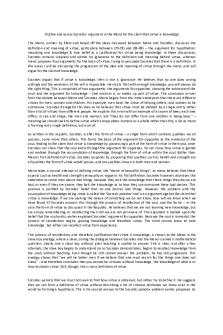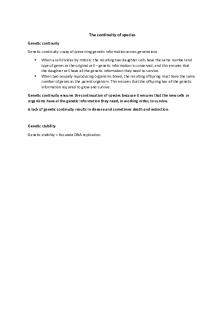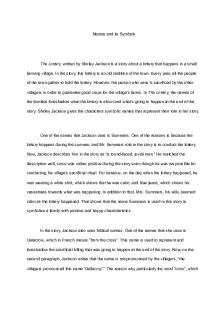The stomach is a J-shaped organ that receives the bolus and aids in its chemical and mechanical digestion PDF

| Title | The stomach is a J-shaped organ that receives the bolus and aids in its chemical and mechanical digestion |
|---|---|
| Course | Human Anatomy and Physiology with Lab I |
| Institution | The University of Texas at Dallas |
| Pages | 2 |
| File Size | 53.4 KB |
| File Type | |
| Total Downloads | 82 |
| Total Views | 114 |
Summary
The stomach is a J-shaped organ that receives the bolus and aids in its chemical and mechanical digestion...
Description
The stomach is a J-shaped organ that receives the bolus and aids in its chemical and mechanical digestion The stomach is an expandable tubelike organ found in the upper left quadrant of the peritoneal cavity. The major functions of the stomach are to (1) temporarily store ingested food received from the esophagus, (2) mechanically digest food through muscular contractions, and (3) chemically digest food through the action of acid and enzymes. Ingested substances combine with the secretions of the stomach glands, producing a viscous, acidic, soupy mixture of partially digested food called chyme (KI . M). This section examines the anatomy of the stomach and then details these important functions. Gross Anatomy of the Stomach The stomach has the shape of an expanded J (Figure 24–12). A short lesser curvature forms the medial surface of the organ, and a long greater curvature forms the lateral surface. The anterior and posterior surfaces are rounded. The shape and size of the stomach can vary greatly from person to person and even from one meal to the next. In an “average” stomach, the lesser curvature is approximately 10 cm (4 in.) long, and the greater curvature measures about 40 cm (16 in.). The stomach typically extends between the levels of vertebrae T7 and L3. We divide the stomach into the following four regions (see Figure 24–12): ■ The Cardia. The cardia (KAR-de . -uh) is the smallest region of the stomach. It consists of the superior, medial portion of the stomach within 3 cm (1.2 in.) of the junction between the stomach and the esophagus. The cardia contains abundant mucous glands. Their secretions coat the connection with the esophagus and help protect that tube from the acid and enzymes of the stomach. ■ The Fundus. The fundus is the region of the stomach that is superior to the junction between the stomach and the esophagus. The fundus contacts the inferior, posterior surface of the diaphragm (see Figure 24–12a). ■The Body. The area of the stomach between the fundus and the curve of the J is the body, the largest region of the stomach. The body acts as a mixing tank for ingested food and secretions produced in the stomach. ■ The Pyloric Part. The pyloric part (pı . -LOR-ick; pyloros, gatekeeper) forms the portion of the stomach between the body and the duodenum (first segment of the small intestine). It is divided into a pyloric antrum, which is connected to the body, a pyloric canal, which empties into the duodenum, and the pylorus (pı . -LOR-us), which is the muscular tissue surrounding the pyloric orifice (stomach outlet).
During digestion, the shape of the pyloric part changes often. A thickening of the circular layer of muscle within the pylorus, called the pyloric sphincter, regulates the release of chyme into the duodenum....
Similar Free PDFs

The Firm and Its customers
- 7 Pages

THE ORGAN SYSTEMS Vocabulary
- 2 Pages

Animal Nutrition and Digestion
- 7 Pages
Popular Institutions
- Tinajero National High School - Annex
- Politeknik Caltex Riau
- Yokohama City University
- SGT University
- University of Al-Qadisiyah
- Divine Word College of Vigan
- Techniek College Rotterdam
- Universidade de Santiago
- Universiti Teknologi MARA Cawangan Johor Kampus Pasir Gudang
- Poltekkes Kemenkes Yogyakarta
- Baguio City National High School
- Colegio san marcos
- preparatoria uno
- Centro de Bachillerato Tecnológico Industrial y de Servicios No. 107
- Dalian Maritime University
- Quang Trung Secondary School
- Colegio Tecnológico en Informática
- Corporación Regional de Educación Superior
- Grupo CEDVA
- Dar Al Uloom University
- Centro de Estudios Preuniversitarios de la Universidad Nacional de Ingeniería
- 上智大学
- Aakash International School, Nuna Majara
- San Felipe Neri Catholic School
- Kang Chiao International School - New Taipei City
- Misamis Occidental National High School
- Institución Educativa Escuela Normal Juan Ladrilleros
- Kolehiyo ng Pantukan
- Batanes State College
- Instituto Continental
- Sekolah Menengah Kejuruan Kesehatan Kaltara (Tarakan)
- Colegio de La Inmaculada Concepcion - Cebu












